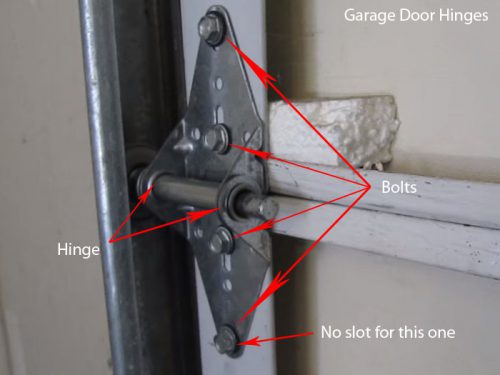Most residential garage doors consist of four panels attached to each other with hinges. When you open the door and it goes around the bend, the hinges hold the panels together. Many manufacturers make hinges of thin metal that is especially prone to rust and corrosion, but there are also high quality hinges that last the life of the door.
When hinge repair is needed?
Can you notice cracks or separation in the hinges? Are there any signs of rust or deterioration? If yes, then you will probably have to replace them.
If you cannot notice serious problems, yet hinges are making noise and sticking, try lubricating them with silicone spray – this may solve the issue.
How to lubricate garage door hinges
Oiling your garage door hinges keeps them in good functioning order and prevents them from rusting or growing squeaky.
Squirt a small amount of silicone spray into the area where the two sleeves rub against each other. Open the door halfway and oil it again. Lift and close the door a few times so as to make the silicone spray lubricate moving areas. Do the hinges move freely and quietly? If no, spray additional lubricant. If the lubricant drips, wipe it with a clean rag.
How to replace garage door hinges
If lubricating garage door hinges has not resolved the problem, try replacing them. Replacement hinges are rather cheap. They are available at most home supply stores.
This task if fairly simple, it usually takes not more than 1-3 hours.
You will need an adjustable wrench or a box wrench to remove the screws. It will be easier to work if you have impact drill, but this tool is not indispensable.
Typically, there is a progression of hinges from a number 1 hinge to a number 10 hinge. The number corresponds with the size. You need to replace a number 1 hinge to a number 1 hinge, a number 2 hinge to a number 2 hinge etc. It is reasonable to begin with either the number 1 hinge or with the top of the first panel on the bottom of the door.
Replace the hinges one at a time. If you remove all of them, the door will fall apart. Take off all the four self-threading screws, and the hinge will come loose. Now it can be removed.
Take the new hinge and find its top. The top has a slot for a hole, while the bottom of a hinge has a perfectly round hole. Also, the number of the hinge can be seen on its bottom part.
Put the first screw into the new hinge, starting from the bottom hole (the one that is not slotted). In this way you will align the hinge. Now install three more screws. Make sure not to overtighten the bolts.
We should point out that some manufacturers use a different system of hinges. Hinges may be constructed into the door sections so that it is very difficult to replace them. However, the instruction above will suit the most common doors.

